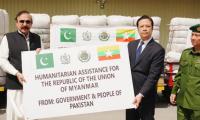LAHORE: Currently, there is a break in economic growth. It is a sign of failure as far as the government’s fiscal policy is concerned. It is borrowing heavily from domestic sources as the foreign funds are not enough to plug fiscal gaps.
When a state borrows domestically, it is monetised, and the capital cost of sovereign debt is zero. High interest rates and inflation are the outcome of this fiscal borrowing.
This is the reason that inflation in Pakistan has not been fully tamed.
It did come down during COVID-19 peak due to low crude oil and commodity rates and decline in consumption.
However, it still hovers around nine percent. The interest rates in Pakistan are the highest in the region because the central bank sees inflationary pressures in the air.
The banks happily give credit to the government at Karachi Inter Bank Overnight Rate (KIBOR) plus two percent without any risk of default. Since the government is squeezed for funds for even its general non development expenditures, it axes the development expenditure.
Development expenditure is in fact an investment that stimulates growth. In the absence of development, the infrastructure instead of being upgraded deteriorates. The growth first stagnates and then retards. After two years of ignoring development, the GDP growth has evaporated.
The inability of the state to transparently manage the energy sector is playing havoc with our industries. We still see many areas of the country suffering from long hours of load shedding.
It is more due to mismanagement than real shortages. The power distribution companies continue to post heavy line losses which are subsidised by the state.
Revenue losses due to non-collection of bills are as high as line losses. The defaulters continue to enjoy electricity supply.
Meanwhile, subsidy meant for the poor is distributed to all segments of the society. Power tariff for three-phase meters, is almost double than the power tariff for single-phase meters.
Single-phase meters have the same tariff during peak hours, while it is 60 percent high in three-phase meters. This is the reason that the most affluent families have installed numerous single-phase meters at their residences.
Media has reported dozens of single-phase connections at the residences of political leaders on both sides of the political divide. This way, by dividing consumption on these meters they avail the subsidy that state provides to poor consumers on up to 300 units.
This is the outcome of an unplanned subsidy that all segments of the society could avail. It might even be costing the state over Rs50 billion in subsidies to the affluent.
There should be targeted power subsidies. The government has identified millions of poor families through Benazir Income Support Program (BISP or Ehsaas). All consumers should pay the full electricity bill without any subsidy and the poor should get the power subsidy through BISP.
Industrial consumers should be preferred over other consumers to keep the wheel of the employment generating manufacturing sector moving. At current governance level, no one should expect a full turn around immediately.
At least two-three percent of the budget deficit is due to bad governance. The government should first make sure that the overall deficit does not exceed five percent of the GDP (Last year it was 8.5 percent and a year ago it was over nine percent).
The Public Sector Development Program (PSDP) should have ensured allocation of three-four percent of GDP and there should be no cut during the financial year under this head.
To make up for infrastructure deficiencies, some projects equivalent in value to at least 1-1.5 percent of the GSP should be executed through Public-Private partnership in the most transparent way.
Private sector would come if the returns are lucrative.
Growth from now on should be with an aim to redistribute the benefits more towards the poor. All general subsidies like the ones given on flour and power consumers should be immediately replaced with targeted subsidies.
Priority should be given to education, health, and drinking water supply. All new recruitments should be immediately frozen except for teachers and healthcare staff.
Growth policy is planned according to the prevailing economic situation.
The current situation demands that the central bank should forget about hot money and concentrate on facilitating the industrial sector.
It should ensure stability of rupee. State should reduce all unproductive wasteful expenditures. In fact, the non-development expenditure should be brought back to the level it was in 2017-18 when this government assumed power. Even then growth under the current circumstances would improve slowly.
Honda officials posing for a photgraph. —APP/FileKARACHI: Honda Atlas Cars Pakistan Ltd has achieved a major...
SOS children village's children showing bags donated by Emirates International Airlines. — Emirates...
Automobiles at the shipping terminal are shown from the view of a drone in San Diego, California, US, March 26, 2025....
Key challenge lies in whether the ruling elite is willing to implement changes that could weaken their grip on power
A woman holds a smartphone displaying the logo of social network X . — AFP/FileElon Musk said his xAI artificial...
A representational image of a person using his cellphone for a digital transaction. — Unsplash/FileKARACHI: Chief...







